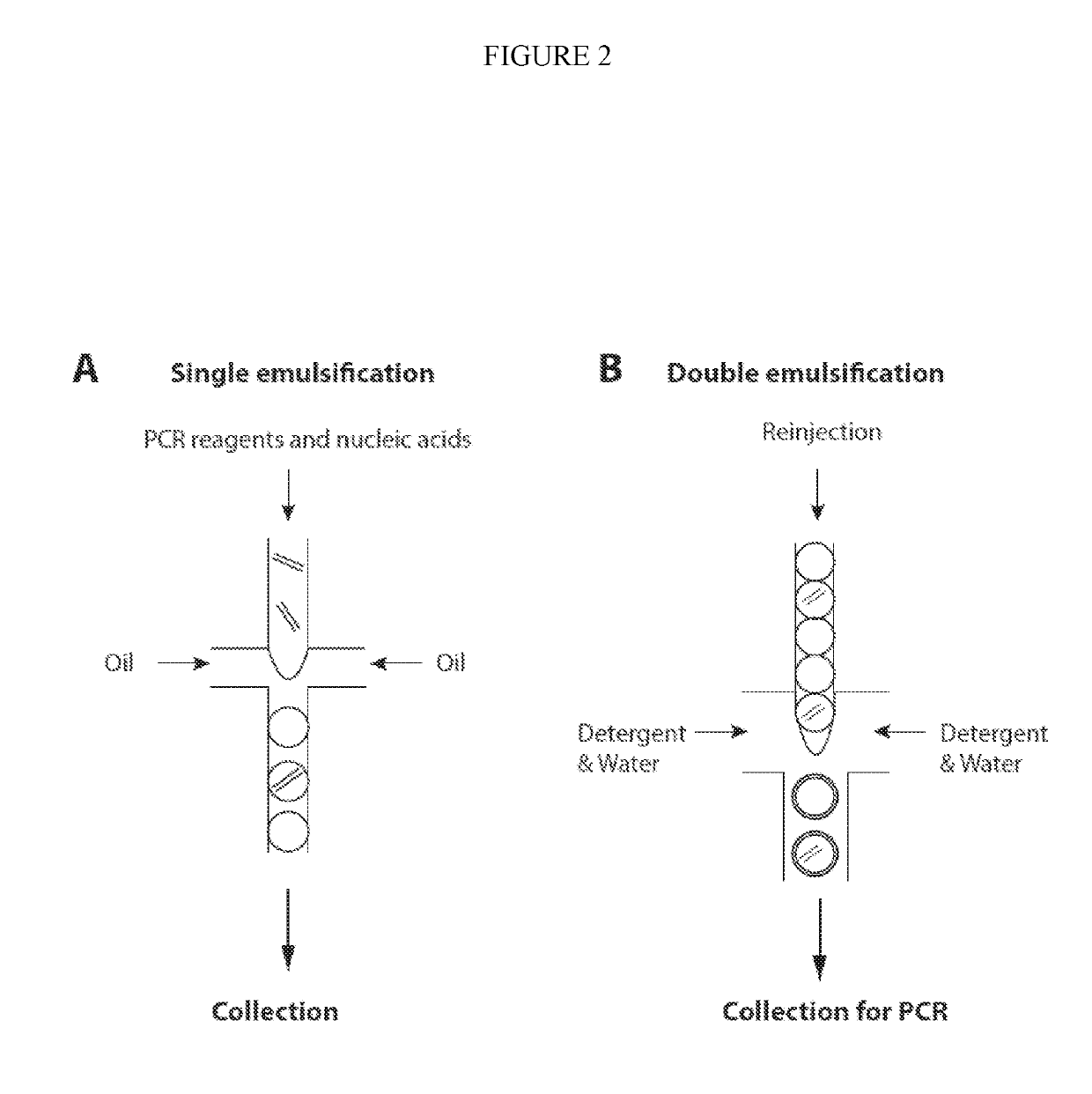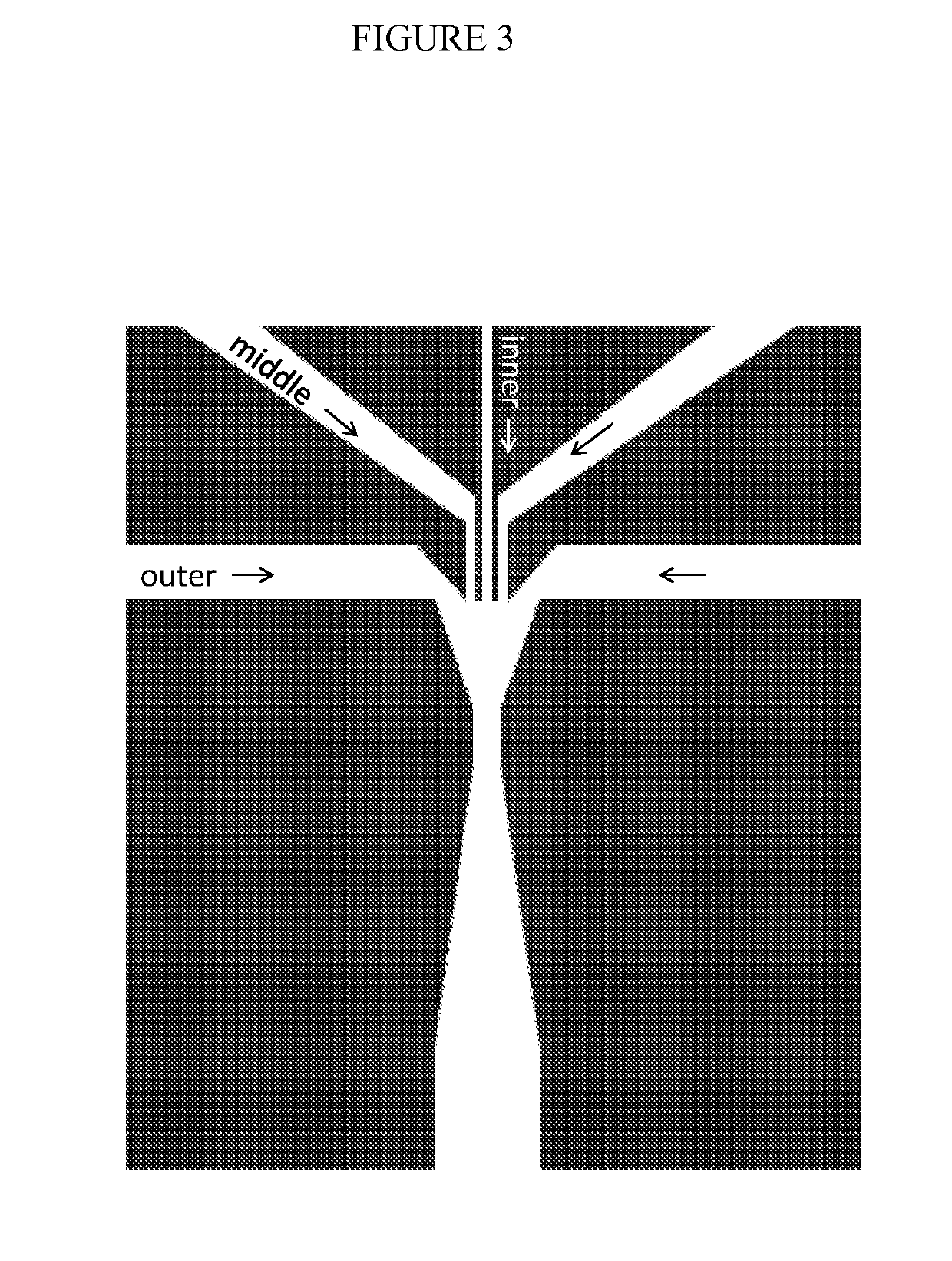Combined multiple-displacement amplification and PCR in an emulsion microdroplet
a technology of emulsion microdroplet and amplification, which is applied in the field of combined multiple displacement amplification and pcr in an emulsion microdroplet, can solve the problems of overflowing the amount of sorted dna of interest, the digital pcr technique of the droplet, and the inability to identify disease-causing mutations. to achieve the effect of facilitating high-throughput sequencing and facilitating the identification of disease-causing mutations
- Summary
- Abstract
- Description
- Claims
- Application Information
AI Technical Summary
Benefits of technology
Problems solved by technology
Method used
Image
Examples
example 1
of Nucleic Acids Using Double Emulsion PCR
[0439]Materials and Methods
[0440]Microfluidic chips were fabricated using standard photolithography techniques in poly(dimethylsiloxane) (PDMS). To produce a master, a layer of SU-8 photoresist (Microchem) was spun onto a silicon wafer, and then expose to UV light from a Blakray device under a mylar mask (Fineline Imaging). The wafer was then baked at 95° C. on a hotplate for 1 min and then developed in Propylene glycol monomethyl ether acetate (PGMEA). PDMS polymer and crosslinker mixed in an 11:1 ratio was then poured over the master and then baked at 75° C. for 4 hours. The device was then peeled from the master and holes were punched using a 0.75 mm biopsy coring needle. After that, the device was bonded to a glass slide following oxygen plasma treatment. To make the device channels hydrophobic, Aquapel was flushed into the channels, after which the device was baked in an oven for 20 mins at 65° C. The thickness of the photoresist was ma...
example 2
Example of FACS Analysis of Double Emulsions
[0447]Double emulsion microdroplets may be sorted via FACS. Exemplary conditions for such sorting are as follows: Double emulsion microdroplets are diluted with PBS in a 1:1 ratio and transferred to a 12×75 mm round bottom tube for analysis with a FACSAria IIu (BD Biosciences). PBS is used as the sheath fluid and events are run with a flow rate that corresponded to 200 events s−1. The cytometer is maintained at a temperature of 4° C. and the tube is rotated at a speed of 300 rpm during event recording. For detection of FITC and TaqMan® probes, FITC-BSA and the TaqMan® probe are excited with a 488 nm laser and their emission passed through a 530±30 nm bandpass filter with a 505 nm low-pass filter in series.
example 3
Example of Nucleic Acid Detection Via PCR in Giant Unilamellar Vesicles (GUV)
[0448]Demonstrating Microfluidic Generation and FACS Sorting of Thermostable Femtoliter GUVs
[0449]Giant Unilamellar Vesicles (GUVs) are sacs of membrane-bound aqueous fluid suspended in a miscible aqueous phase. Like droplets, they can encapsulate regents and thus act as compartments for biological reactions. Depending on the chemistry of the membrane, GUVs can be made selectively permeable, trapping macromolecules like DNA and RNA, but allowing small molecules, like nucleotides and ATP, to pass freely through their membrane. This selective permeability makes reactions in GUVs more efficient than in emulsion droplets because, as the reaction progresses, new reagents can diffuse in. The challenge to performing reactions in GUVs, however, is that they are fragile, consisting of a membrane a few molecular layers thick that can easily rupture due to mechanical stress or heat. To perform PCR in GUVs, a membrane ...
PUM
 Login to View More
Login to View More Abstract
Description
Claims
Application Information
 Login to View More
Login to View More - R&D
- Intellectual Property
- Life Sciences
- Materials
- Tech Scout
- Unparalleled Data Quality
- Higher Quality Content
- 60% Fewer Hallucinations
Browse by: Latest US Patents, China's latest patents, Technical Efficacy Thesaurus, Application Domain, Technology Topic, Popular Technical Reports.
© 2025 PatSnap. All rights reserved.Legal|Privacy policy|Modern Slavery Act Transparency Statement|Sitemap|About US| Contact US: help@patsnap.com



